#travel literature
Text

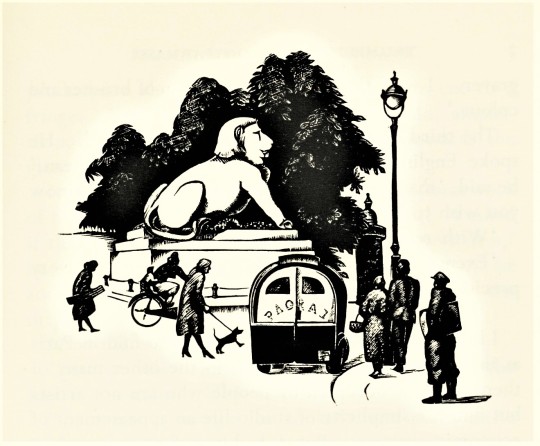

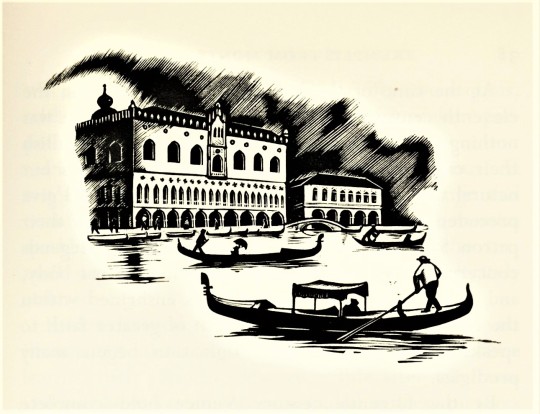
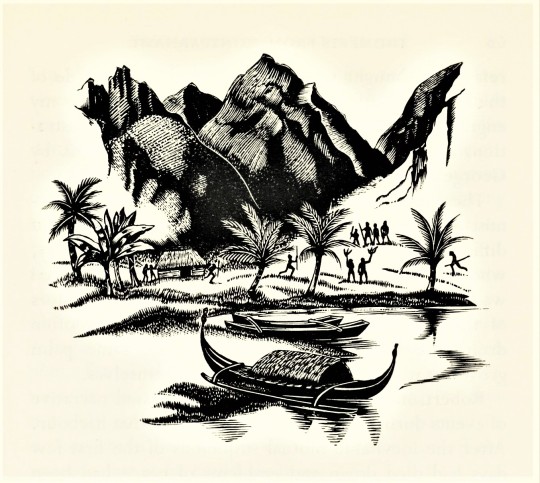
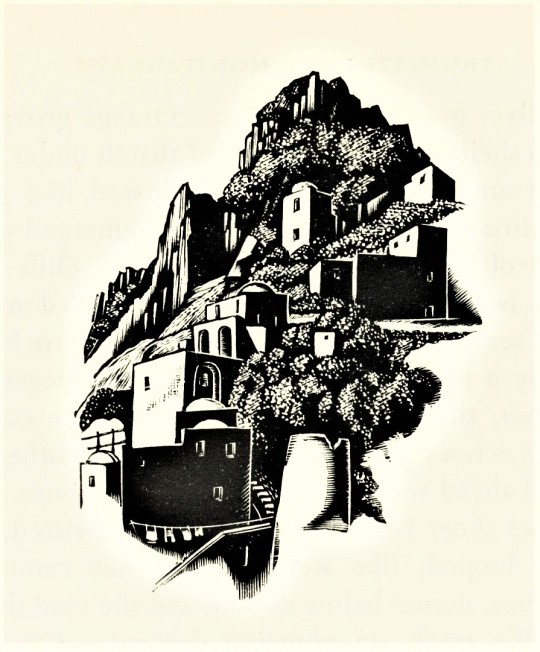
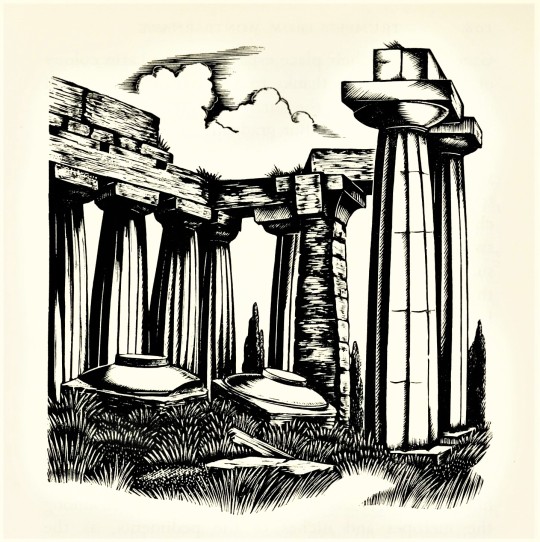



Wednesday Wood Engraving
This week we highlight a few of the 40 wood-engraved illustrations by noted Irish wood engraver and fine press publisher Robert Gibbings (1889-1959) for his 1955 publication Trumpets from Montparnasse. We hold both the British (J. M. Dent & Sons) and American (E. P. Dutton & Co.) first editions.
The one-time owner of the Golden Cockerel Press, Gibbings was a voracious traveler and travel writer. Trumpets from Montparnasse was based on his travels in France and Italy. Gibbings's narrative ranges from Île de Ré off the coast of La Rochelle, France, to Venice, and from Postino south of Naples to Paris and the Montparnasse district itself, along with a slight detour to his memory of Tahiti and his illustrations for The Discovery of Tahiti published by the Folio Society in the same year as Trumpets.
The back cover of the American edition includes a portrait of Gibbings at the engraving table. Our British edition, a gift from our friend Jerry Buff, bears the bookplate of Muriel Faulkner MacAdam, who we learned was the long-time spouse of the noted American colorimetry scientist David L. MacAdam. We don't know why we find that interesting, but we do.
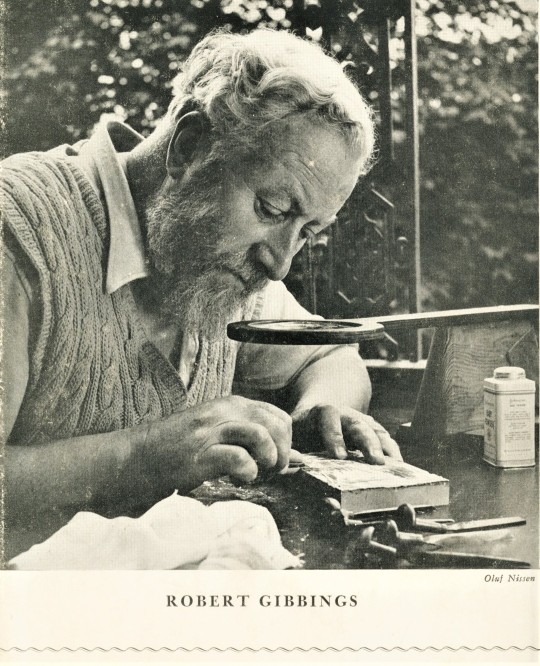
View more posts related to Robert Gibbings.
View more posts with wood engravings!
#Wood Engraving Wednesday#wood engravings#wood engravers#Robert Gibbings#Trumpets from Montparnasse#travel literature#J. M. Dent & Sons#E. P. Dutton & Co.#Jerry Buff#France#Italy
42 notes
·
View notes
Text
I go dreaming into the future, where I see nothing, nothing. I have no plans, no idea, no project, and, what is worse, no ambition. Something – the eternal ‘what’s the use?’ – sets its bronze barrier across every avenue that I open up in the realm of hypothesis.
Gustave Flaubert, Flaubert in Egypt: A Sensibility on Tour, 1849
#gustave flaubert#french literature#existential despair#a sensibility on tour#travel literature#quotes#dark acadamia aesthetic#classic literature
25 notes
·
View notes
Text
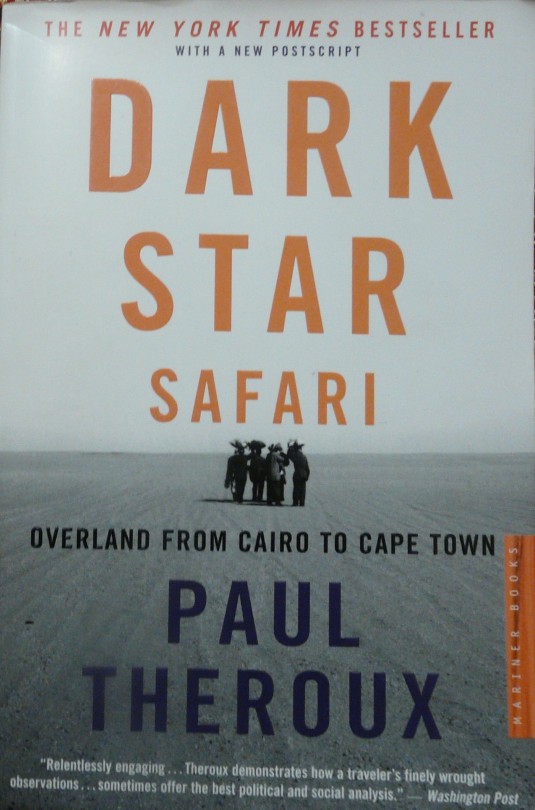
Book Review
Dark Star Safari: Overland from Cairo to Cape Town
by Paul Theroux
Two decades ago, the novelist and travel writer Paul Theroux took an overland trip through Africa, starting in Cairo, Egypt and ending in Cape Town, South Africa. This certainly isn’t the safest or the most comfortable means of experiencing the supposed “dark continent”, but it makes for some interesting experiences and insights. Keeping in mind that Theroux’s observations are just one point of view among many, his resulting book Dark Star provides a unique look at a region of the world that holds a permanent place off the beaten path.
While Dark Star is an easy book to read, breaking it down into its individual elements is a good way to approach its merits and examine its flaws. The first element of importance is Theroux’s sense of place. Wherever he goes, the author describes what he sees and the vibe he gets from his surroundings. Starting on the tourist trail in Egypt, he heads south through Sudan, Ethiopia, Kenya, Tanzania, Uganda, Malawi, Zimbabwe, Mozambique, Zambia, and South Africa. You quickly get a sense of what he appreciates and what he doesn’t. He doesn’t like sites that are swarmed with tourists, nor does he like cities with their concentrations of crime and poverty. He also doesn’t like the “death traps” as he calls public transportation which are usually over-croded minivans driven at dangerous speeds on poorly maintained roads, pockmarked with hippopotamus-sized potholes. If you’ve ever traveled in a Third World country, you will know exaclt what he is talking about.
The places that Theroux does like are usually rural, especially farm lands or jungle villages. These are the places where he sees Africans at their best, meaning Africans being Africans in the absence of corrupt and filthy cities built up on the foundations of European colonialism. Some of the book’s best passages involve descriptions of the pyramids in Sudan which are rarely seen by tourists, a boat trip across Lake Victoria, another boat trip from Malawi across the Zambezi over the border into Zimbabwe, and the pristine countrysides of Zimbabwe and South Africa. All places, whether Theroux likes them or not, are described with language that is clear, simple, and direct, making it easy to visualize what he sees.
Another element that is done to near perfection is writings about the people. Theroux talks with tour guides, people on the streets and in the villages, farmers, nuns, educators, government officials, Indian businessmen, prostitutes, authors, intellectuals, and ordinary people. Just like with the places he goes, he describes these people vividly with precision so that you feel like you quickly get to know them. But not everyone is to his liking. He gets into small argument with a fanatical Rastafarian in Ethiopia, a little ornery with physically fit young men who refuse to work, government officials who demand bribes to do their jobs, and he really gives a hard time to a young American missionary woman about the psychological damage that her evangelical ministry is doing to the local people. There is also plenty of anger directed at clueless tourists as well as NGO and charity workers who he sees as being the Westerners who do the most damage to Africa.
The third element of importance is the author, Paul Theroux himself, and his thoughts and commentaries on everything he sees. Before getting into this subject, it should be mentioned that Theroux had a purpose to his journey. In the 1960s he worked as a Peace Corps volunteer, teaching in Malawi. After getting involved with a Leftist political group, he got fired then accepted a teaching position at a college in Uganda. He wanted to return and see what results, if any, his contributions to Africa grew into. What he found was a major disappointment. The charming campuses and villages where he had lived were in ruins and instead of a thriving civilization, he saw emaciated beggars, starving children, an ignorant populace, and chronically corrupt politicians. Shops that were formerly owned by Indian immigrants were abandoned and burnt to the ground, the result of a campaign of ethnic cleansing. African people wanted to buy from shops owned by Africans, but Africans never took control over the businesses after the Indians were killed or chased away. They resorted to begging, theft, petty crime, prostitution, and laziness instead of making an effort to build better villages for themselves. Due to the hopelessness of African society, the most educated citizens fled to America or Europe instead of staying in their home countries where they were most needed.
Throughout his travels in Tanzania, Uganda, and Malawi, Theroux gets increasingly bitter and cynical. He wanted to see Africans thriving and they weren’t. He directs all his wrath towards the Western charities and NGOs who he says are making the local people dependent on aid rather than learning how to run their societies for themselves. Even worse, these organizations work by bribing corrupt politicians to allow them to do work there, keeping greedy and psychotic leaders in positions of power they don’t deserve. Theroux points out that rural people who have given up on the hopeless market economy and returned to subsistence farming are the happiest and healthiest Africans he encounters. Heecomes close to advocating for a type of post-capitalist agrarian anarchism.
Some readers have criticized Theroux for his pessimistic views on contemporary Africa, but he does cite studies that support what he says. He also encounters a lot of Africans in several different countries that agree with him. To make sense of his negativity, you also have to remember that traveling overland through Africa is not exactly stress free. Anybody who has been on an extended backpacking trip anywhere in the world will tell you that traveler’s fatigue is a real thing. Theroux took a longer than average trip through one of the most underdeveloped regions in the world, got shot at by Somali bandits, stuck in the middle of nowhere when his transportation broke down, and got sick with food poisoning, magnifying his traveler’s fatigue to a outsize extent. These circumstances would make you grouchy too. But even in the darkest times, Theroux never loses his appreciation for Africa, the wildlife, the landscapes, and the people who are trying to make the best of their situations. Besides, by the time he crosses the river from Malawi into Zimbabwe, his mood really lightens up.
Dark Star is an engaging travelogue that should be read both critically and with an open mind. All the while, remember that this is Paul Theroux’s singular point of view. That doesn’t make it wrong; that just means that there are other points of view to take into account that may go against what he says even if they don’t necessarily invalidate his opinions. He saw what he saw and he expresses it well. This is raw and honest travel writing and if you haven’t been tough enough to make the same kind of journey, you’re not in a good place to be judgmental of the conclusions he draws.
3 notes
·
View notes
Text
“ Kabul (5900 ft., 36 miles from Charikar), June 11th [1934].
From Herat to Kabul we have come 930 miles, of which forty-five were on horseback.
A winding hill-road brought us down from the Charikar plateau to a smaller plain inside a ring of mountains; running water and corrugated iron glinted among its trees. At the entrance to the capital the police deprived the Vicar and the Curate of their rifles, to their great distress; but being in turbans, no one would believe they were government servants. We drove to the Foreign Office, where hot-red English ramblers were climbing over iron railings; to the hotel, where there was writing-paper in each bedroom; to the Russian Legation, where they had had no answer to M. Bouriachenko’s telegram; to the German shop, where they refused to sell us hock without a permit from the Minister of Trade; and finally to our Legation, where the Minister, Sir Richard Maconochie, has asked us to stay. It is a white house, dignified with pillars and furnished as it would be at home, without any mosquitonets or fans to remind one of the Orient. Christopher says he finds it peculiar to be in a room whose walls aren’t falling down.
Opinion at the Legation agrees on the silliness of refusing the Russian diplomats in Kabul transit visas through India. Even if they go as far towards the frontier as Jelallabad, the Government of India sends in official complaints. The result is a sort of gentlemen’s agreement between the two Legations and the Afghan Government that the English shall not travel in the north of the country and the Russians in the south. That is why the authorities at Mazar could not allow us to the Oxus, though they would not admit such a reason lest it appear a limitation of their sovereignty. We were lucky to have got as close as we did, particularly as it appears that Haji Lai Mohammad, who bought the car, and our chauffeur Jamshyd Taroporevala, spread a tale that we were Secret Service agents engaged in map-making. Next time I do this kind of journey, I shall take lessons in spying beforehand. Since one has to put up with the disadvantages of the profession anyhow, one might as well reap some of its advantages, if there are any.
British diplomacy in Kabul just now hangs on the Minister’s roses. At the King’s birthday party, on June 3rd, they were in full flower, and the Afghans, who are all rose-lovers, had never seen such big formal blooms. Next morning, visiting cards from the Minister of Court were fluttering from the finest trees; they had been left by his gardener in the night. Now all the other ministers want cuttings too, and are also in a turmoil over the peonies, which have been promised them for next year.
Magnificent as the formal roses are, I yet prefer an Afghan tree which stands by the gate in front. It is fifteen feet high and covered with such a profusion of white blossoms that hardly a leaf is visible. “
Robert Byron, The Road to Oxiana; first published by Macmillan & Co. Ltd, London, 1937.
#Robert Byron#The Road to Oxiana#Afghanistan#central Asia#XX century British literature#travel literature#English literature#Hindu Kush mountains#20th century#1930s#modernization#European empires#British Empire#British India#South Asia#Russian Empire#inter-war period#Kabul#Ghazni#Jalalabad#Charikar
7 notes
·
View notes
Text








#alıntı#kitap#reading#landsccape#booklover#books#culture#home lifestyle#books and libraries#literature#photography#writing#currently reading#ctiy#travel#landscape#vintage#history#arte#arhitecture#trees#view#scenery#bookworm#romance quotes#edebiyat#studyblr#studyspo#tumblarians#spilled thoughts
14K notes
·
View notes
Text




#photography#my photography#yörüngede#cottagecore#artists on tumblr#flowers#RadarPlz#landscape#aesthetic#travel#popular#room#home#design#reading#literature#pets#architecture#nature#books#books and libraries#study#dark acamedia#aww#kittens#kitties#animals#cute#light academia#interior
40K notes
·
View notes
Text




#moonlight#moon#full moon#landscape#paradise#nature#adventure#explore#photography#aesthetic#home lifestyle#home decor#dark acadamia aesthetic#photographers on tumblr#travel#english literature#desing#fashion#illustration#inspiration#motivation#cottage witch#fall aesthetic#chaotic academia#architecture#curators on tumblr#clouds#beauty#scenery#naturecore
10K notes
·
View notes
Text

📍Asthall, Oxfordshire, England, United Kingdom 🇬🇧
#dark academia#light academia#classical#academia aesthetic#escapism#academia#books and libraries#classic literature#books#architecture#place#photography#travel#Asthall#Oxfordshire#england#united kingdom#town#fairytale#beautiful#royal core#cottage core#cozy#aesthetic#academic#mood#vibe#tumblr#country
5K notes
·
View notes
Text
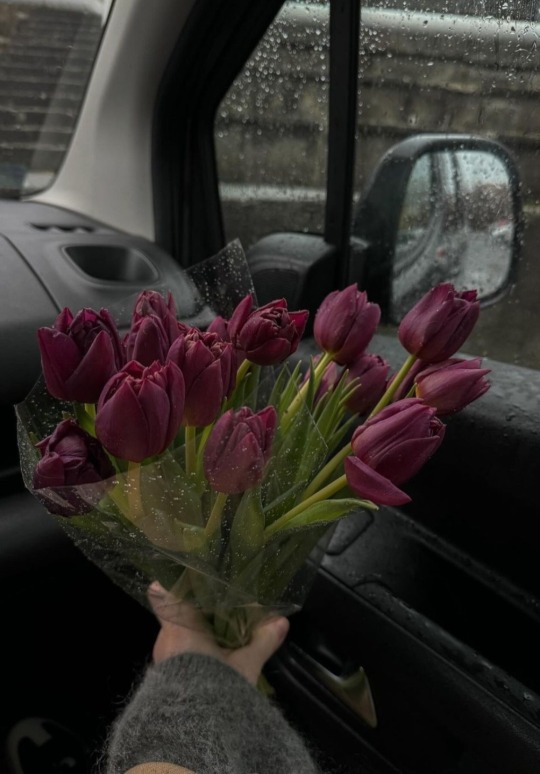
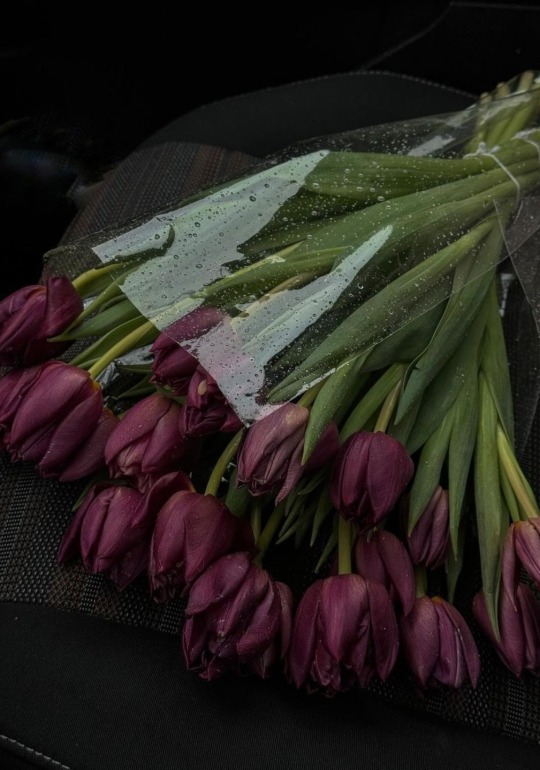
#photography#my photgraphy#cottagecore#artists on tumblr#flowers#radarplz#landscape#aethestic#aestethic#aesthetic#aestehtic#travel#yörüngede#popular#room#home#desing#reading#literature#pets#architecture#nature#books#books and libraries#study#dark acamedia#tulips#tulip flower#superkursunaskr#fypシ゚viral
4K notes
·
View notes
Text
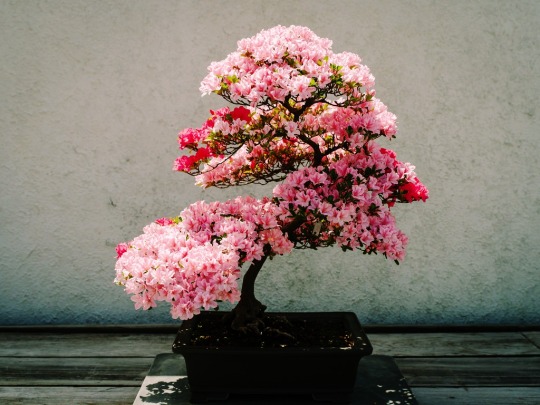

Umma ki küsmeyesin. henüz yeşermemiş nice renkli umutlar var..
#photography#yörüngede#artists on tumblr#cottagecore#landscape#my photography#aesthetic#popular#flowers#travel#RadarPlz#room#home#design#reading#literature#pets#architecture#nature#books#books and libraries#study#dark acamedia#aww#kittens#kitties#animals#cute#light academia#interior
4K notes
·
View notes
Text



#art#quotes#motivation#words#aesthetic#travel#poetry#writing#poets on tumblr#writers#books and libraries#love#literature#books libraries#culture#poetas en español#beauty#writers on tumblr#inspiration#architecture
3K notes
·
View notes
Text

Book Review
Honey From a Weed: Fasting and Feasting in Tuscany, Catalonia, the Cyclades and Apulia by Patience Gray
When it comes to food, Europeans have great traditions. In America, on the other hand, we make ourselves an easy target of ridicule. For example, think of drive-through windows at restaurants. Not only is fast food crappy tasting and terrible for your health, but eating a meal in your car is just downright gross. No class, no style, no elegance, no taste. People turn their vehicles into motorized garbage cans this way. I realize not every meal can be gourmet, but with a minimal amount of effort you can be a little less trashy. And its nice that we have a much broader range of ethnic options than we used to, but so many of these restaurants Americanize their food to the point where they no longer resemble the authentic dishes you get in their nations of origin. I’ve had Thai curries that were so sweet they tasted like desserts and larb without fish sauce. Ask for something spicy and they dump a ton of salt in it. Burritos, nachos, and fajitas aren’t eaten in Mexico. Hummous and falafels aren’t Greek, having their origins in Palestine. Greek people eat massive amounts of seafood but you never see fish on a Greek menu in America. The vomit they serve at The Olive Garden bears little resemblance to real Italian food. Don’t get me going on how fake our Chinese food is. Our fruits and vegetables taste like plastic, unlike the produce in other countries. Obviously not all food in America sucks, but more than half of it does. At least we have better food than British people do. What hell is marmite? Industrial sludge on bread?Axle grease in a jar? It tastes like cigarette ashes with shoe polish.
Mediterranean people, on the other hand, know all about food. So when I heard about Patience Gray’s Honey From a Weed, I knew I had to read it. The author spent time living in rural Mediterranean countries during the 1960s and 1970s with her husband, an artists she calls The Sculptor rather than using his real name. She witnessed the farming lifestyle of people in Catalonia, Tuscany, the Greek island of Naxos, and Apulia, the part of Italy shaped like the heel of the boot, a place where the local language is a mixture of Italian and Greek. As she wrote down her collection of recipes, she decided to put them into context with passages about how the cooking materials were collected or harvested, and detailed all this with short passages about the culture of the people she encountered. What results is a cookbook you can read as part ethnography, part memoir, part travelogue, and part philosophical discourse examining what it means to live a good life.
The recipes cover a wide range of ingredients with chapters on farmed vegetables, wild herbs, mushrooms, seafood, and game. If you’ve ever wondered how to cook a fox, a horse, or a sea urchin you need look no further. If you want to cook everyday items like chicken, mussels, or zucchini you can find that here too. A lot of the recipes are redundant, being variations of food fried in olive oil with garlic and diverse seasonings, occasionally with anchovies or tomatoes thrown in. But here is the catch: the types of tomatoes, or other vegetables used, depends on the season since different kinds of produce naturally ripen at different times of the year depending on the season and climate. These people did not have supermarkets that have the same industrially-grown, genetically altered produce all year long the way we do in the 21st century. European farmers lived so close to nature that the seasons dictated what kind of game you had, what fruits you could pick, or what kind of wine you could drink. It may have been a harder life, but the food was of much higher quality. In the 1970s, Patience Gray realized these cultures were vanishing so she wrote all her observations down for posterity.
The author, rightly so, must have thought that not many people would be interested in a cookbook full of recipes that most people probably wouldn’t use or even couldn’t use considering that some of these food items no longer exist. Some of the cooking utensils are rare or obsolete. In my favorite chapter of all, she gives a detailed analysis of how cooking over open flames with different varieties of wood complement the flavors of all kinds of dishes. With this in mind, you begin to see why these traditions couldn’t survive. Most of us don’t have the time or the resources to find twenty different kinds of wood to cook twenty different meals.
But to get back to the main point, she made this book readable by adding in passages about the different places she lived in. There are descriptions of villages, architecture, farms, kitchens, and landscapes. She makes mention of some of the rural people and their customs along with musings on their religious and political beliefs. With a healthy contempt for the fascism of Mussolini, she points out that these rural people were mostly anarchists or communists. In our day you can criticize these ideologies all you want, but with hindsight you have to realize that when industrial capitalism is the dominant economic system and your community is famished and living at the edge of death, all those “isms” looked like desirable alternatives.
Finally, Gray iterates her own philosophy, simply put, that lacking something is what makes it pleasurable when you get it. Tomatoes taste like ecstasy when they are harvested because the farmers can’t have them for three-quarters of the year. It’s like saying Christmas wouldn’t be Christmas if you have it every day. This might be a cause of such widespred psychological dissatisfaction in our times. At least that’s what The Unabomber Ted Kaczynski said. In our age of abundance and mass conformity this might not be so clear, yet we may still know it by unconscious instinct. It is why a rare book might sell for $500 while a mass-produced Harry Potter novel will get a book dealer little more than fifty cents. The problem is that Patience Gray states her philosophical position but never explores it in depth.
In fact, she doesn’t explore many ideas at all in depth. Her writing just isn’t that good. It’s interesting that she created a cookbook you can read, but the things to be read are not always clear or even interesting. The recipes get redundant and a bit of a chore to read and some of the rest of it is just weak in its execution. I am in love with the idea of this book, but not the final product.
Patience Gray’s Honey From a Weed is not one of the most memorable books I have come across, but I don’t regret reading it. Having traveled and studied a lot, I can’t say I’m lacking in alternate perspectives on the world and the current state of our society, but I did enjoy imagining myself being in the Mediterranean places she described. It also gave me renewed inspiration for cooking; I learned the best way to cook radicchio and was reminded that I haven’t had any scungilli in a really long time. Once was enough though and I probably won’t be re-reading it this the future.
1 note
·
View note
Text
The Worst Journey in the World by Apsley Cherry-Garrard adapted by Sarah Airriess
Animator turned illustrator @twirlynoodle brings to life the Terra Nova expedition memoir of Apsley Cherry-Garrard with the @WorstJourneyGN from @IndieNovella

View On WordPress
#apsley cherry-garrard#graphic novel#indie novella#sarah airriess#terra nova expedition#the worst journey in the world#travel literature
0 notes
Text

Cuando los vientos cambian de dirección, las tormentas se convierten en suave brisa capaces de refrescar y a la misma vez, acrecentar la flama del alma…
Priscila Alcívar
#literature#writers#tumblarians#movies#travel#museums#architecture#culture#education#design#history#health fitness#books libraries#home lifestyle#books and libraries#sociology#photography#student#quoteoftheday#art
15K notes
·
View notes
Text


new york is overwhelming at times. But, I will never get tired of exploring bookstores.
#studyblr#study blog#nyc subway#nyclife#nyc aesthetic#nycphotographer#nycnights#nyc explorers#nyc#new your city#books and literature#book stuff#bookstore#travel#college#studying#travelling#new york#study notes#university life
2K notes
·
View notes
Text
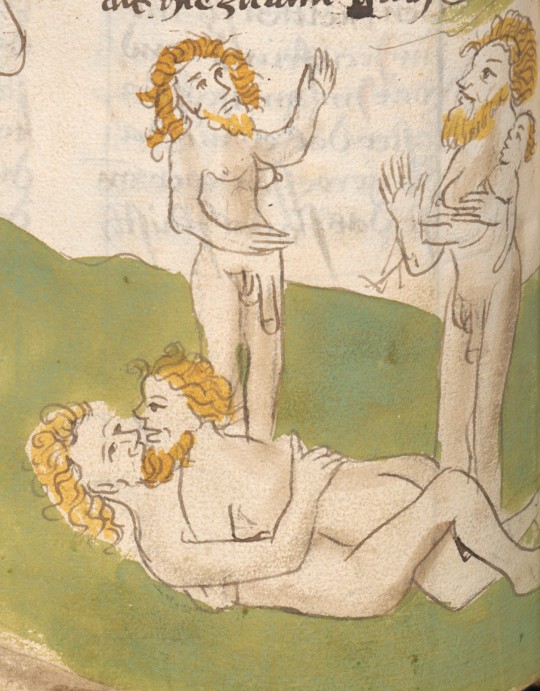


queer sex and more!
in an illustrated medieval travelogue (a german translation of "mandeville's travels"), bavaria/swabia, ca. 1476
source: Vienna, ÖNB, Cod. 2838, fol. 102v
#i feel like this hasn't really been posted on the internet before?? 👀#and none of the existing catalogue descriptions mention the queer imagery at all (disappointed but not surprised)#nor does any of the secondary literature on the manuscript!! (judging by the titles)#you need to understand my approach for this blog is just to browse through hundreds of pages of random digitized manuscripts#ummm anyways#15th century#medieval art#illuminated manuscript#blemmyes#queer#gender stuff#otto von diemeringen#mandeville's travels#jean de mandeville#The Travels of Sir John Mandeville#nudity#medieval studies#gender
1K notes
·
View notes